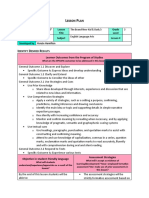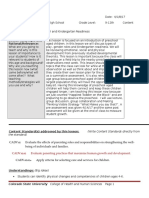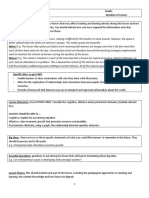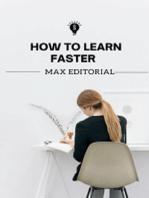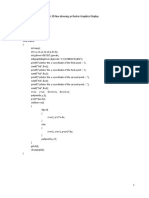Lesson Plan 2
Lesson Plan 2
Uploaded by
api-643579652Copyright:
Available Formats
Lesson Plan 2
Lesson Plan 2
Uploaded by
api-643579652Original Title
Copyright
Available Formats
Share this document
Did you find this document useful?
Is this content inappropriate?
Copyright:
Available Formats
Lesson Plan 2
Lesson Plan 2
Uploaded by
api-643579652Copyright:
Available Formats
CEP Lesson Plan Form
Teacher: Alexandria Branecki Date: 11/17/2022
School: Rocky Mountain High School Grade Level: 10th Content Area: English
Title: Reading Strategies and Guided Reading Lesson #:_1_ of _1_
Lesson Idea/Topic and Rational/Relevance: I’m going to teach reading strategies and tips, as well as
What are you going to teach and why is this facilitate a guided reading activity for the students.
lesson important to these students? What Teaching them reading strategies is really important for
has already happened in this classroom these students because it gives them more clarity on
surrounding the subject you will be how to be successful in reading. A lot of them struggle
teaching? What do students already know? with even picking up the book and a lack of motivation,
Why are you going to teach this topic now so I hope the tips will help support them. The guided
(how does it fit in the curricular sequence)? reading will act as a way for the students to keep track of
What teaching methods/strategy will you their thoughts and conceptions on what is going on in
be use and why? the book at different times. These students have already
participated in about 3 different reading activities for
this book, so they are used to the format by now. By this
point, they should know what has happened through
more than half of the book. I’m going to teach this topic
now because I noticed some mutual frustration amongst
students regarding the reading process and why they
don’t enjoy reading. I included 1 component of the 4-
part mission within my lesson during the “Reading
Strategies and Tips” section—this section will include
nurturing pedagogy because I intentionally designed it to
show great care, compassion, and understanding for the
students throughout their learning process. The teaching
strategies that I plan to use throughout the activity are
guided reading, turn and talk, and the “What makes you
say that?” MTV strategy.
Content Standard(s) addressed by this lesson: (Write Content Standards directly from the standard)
3.1.a.i. Cite strong and thorough textual evidence to support analysis of what the text says explicitly as
well as inferences drawn from the text. (CCSS:RL.9-10.1)
3.1.a.ii. Determine a theme or central idea of a text and analyze in detail its development over the
course of the text, including how it emerges and is shaped and refined by specific details; provide an
objective summary of the text. (CCSS: RL.9-10.2)
Understandings: (Big Ideas)
o Students will be able to effectively engage in a text and draw inferences/conclusions from what
they have read.
o Students will be able to recognize key happenings within a text and summarize what they have
read.
Colorado State University College of Health and Human Sciences Page 1
CEP Lesson Plan Form
o Students will be able to utilize reading strategies and tips to strengthen their reading skills and
comprehension.
Inquiry Questions: (Essential questions relating knowledge at end of the unit of instruction, select
applicable questions from standard)
o How can I engage more effectively with a text?
o How can I find meaning within the text, and form my own interpretations about it?
o Why is it important to read?
Evidence Outcomes: (Learning Targets) AND (Success Criteria) Next to each Learning Target OR
Objectives, state how you are addressing literacy AND numeracy within this lesson.
I can: explain what happened in today’s reading.
This means: I understand how to scan a text, read a text, make meaning from what I read, and
formulate this meaning into words that fully express what I’m thinking.
I can: read more successfully and effectively with the help of reading strategies and tips.
This means: I will be better able to read a text, understand/comprehend a text, summarize a text, and
discuss a text’s meaning and importance.
List of Assessments: Formative: Students are engaging with the journal prompt and answering to the
best of their ability. Formative: Students are actively reading and attempting to comprehend the
material. Formative: Students have completed or attempted to complete the guided reading activity to
the best of their ability. They will be assessed on their effort, accuracy, comprehension, and
understanding after the completion of this activity.
Colorado State University College of Health and Human Sciences Page 2
CEP Lesson Plan Form
Planned Lesson Activities
Name and Purpose of Lesson Reading Effectively: Reading Strategies, Tips, and Guided Reading
Should be a creative title for you and the students to
associate with the activity. Think of the purpose as The purpose of this lesson is to give students more reading comprehension and reading
the mini-rationale for what you are trying to perseverance tips, as well as allow students to guide their own reading in an effective
accomplish through this lesson. way. These students struggle with reading for long periods of time, and potentially
struggle with comprehending what they’re reading, so I’m going to give them some tips
as well as a guided reading activity that will support them in understanding the text more
comprehensively.
Approx. Time and Materials Time: 80 minutes total: 1.5 minutes to get ready for class, 1 minute for expectations and
How long do you expect the activity to last and what explanation, 2.5 minutes for the mindfulness exercise, 12 minutes for journal entry, 5
materials will you need? minutes for quick summary of the novel thus far, 10 minutes on reading strategies and
tips, 48 minutes for independent reading and guided reading activity work time
Materials: Lesson plan, timer, music, mindfulness video, google classroom, review sheet
for book, PowerPoint, book
Anticipatory Set 1. Wiggle Break: (1.5 min) Before we get started, I want to give y’all a minute or so
The “hook” to grab students’ attention. These are to wrap up anything you want to talk about real quick with your friends so that
actions and statements by the teacher to relate the we can focus a little bit more during our mindfulness warm-up. I’ll put a minute
experiences of the students to the objectives of the and a half on the clock so you can get any wiggles or last comments out. Teacher
lesson, To put students into a receptive frame of will play light music during this time.
mind. 2. Expectations: (1 min) Before we begin the mindfulness exercise, *set up
To focus student attention on the lesson. expectations* (laptops and phones away for the next 2.5 minutes, earbuds out,
To create an organizing framework for the let’s be quiet so everyone can focus properly)
ideas, principles, or information that is to 3. Warm up: (2.5) mindfulness exercise: Today’s going to be a little different in
follow (advanced organizers) terms of our breathing/mindfulness exercise. Mindfulness isn’t always about
An anticipatory set is used any time a different breathing or silencing all your thoughts, it can actually just be about focusing on
activity or new concept is to be introduced. one thing and one thing only for a period of time. Too often we have hundreds of
thoughts in our heads circling around, and it’s hard to focus or pinpoint on just
one thing. During this mindfulness exercise, I want you to picture one of the
happiest moments of your life and submerge yourself in this visual. What do you
notice? What do you see, feel, smell, taste, and hear? We’ll do this for 2.5
minutes and then get started. Teacher will play a calming video for background
Colorado State University College of Health and Human Sciences Page 3
CEP Lesson Plan Form
noise during the exercise. Unguided Meditation 5 Minutes | Unguided
Meditation Music
How do you intend to engage your students in
thinking during the Anticipatory Set? The strategy I intend to use is __Wiggle Break and Mindfulness Exercise________
Why are you using it at this point in your lesson? I am using this strategy here because: Students often come to this class with a lot of
energy and a lot of things to talk about with their friends. I will start off the class with a
wiggle break to give the students a chance to get any last minute conversations out so
that they can focus better during the mindfulness exercise. Then, I will facilitate a
mindfulness exercise to help them regulate their feelings and mood and get them ready
for the upcoming lesson. Mindfulness is great for helping students ground themselves
more into the present moment and focus better.
Procedures 1) Wiggle Break: (1.5 min) Before we get started, I want to give y’all a minute or so to
(Include a play-by-play account of what students and wrap up anything you want to talk about real quick with your friends so that we can
teacher will do from the minute they arrive to the focus a little bit more during our mindfulness warm-up. I’ll put a minute and a half on
minute they leave your classroom. Indicate the the clock so you can get any wiggles or last comments out. Teacher will play light
length of each segment of the lesson. List actual music during this time.
minutes.) 2) Expectations: (1 min) Before we begin the mindfulness exercise, *set up
Indicate whether each is: expectations* (laptops and phones away for the next 2.5 minutes, earbuds out, let’s
-teacher input be quiet so everyone can focus properly)
-modeling 3) Warm up: (2.5 min) mindfulness exercise: Today’s going to be a little different in
-questioning strategies terms of our breathing/mindfulness exercise. Mindfulness isn’t always about
-guided/unguided: breathing or silencing all your thoughts, it can actually just be about focusing on one
-whole-class practice thing and one thing only for a period of time. Too often we have hundreds of
-group practice thoughts in our heads circling around, and it’s hard to focus or pinpoint on just one
-individual practice thing. During this mindfulness exercise, I want you to picture one of the happiest
-check for understanding moments of your life and submerge yourself in this visual. What do you notice? What
-other do you see, feel, smell, taste, and hear? We’ll do this for 2.5 minutes and then get
started. Teacher will play a calming video for background noise during the
exercise. Unguided Meditation 5 Minutes | Unguided Meditation Music
4) Journal Entry: Prompts: (Student Choice) (12 min)
a) List 4 of some of the best lessons you’ve learned throughout your life and a brief
statement on why this lesson was important or
Colorado State University College of Health and Human Sciences Page 4
CEP Lesson Plan Form
b) Write out your own recipe for happiness, including the “ingredients”, order of
steps, and amount of “ingredients” you would need (hint: this can be your own
idea of happiness) (minimum of 5 ingredients and 3 steps)
5) Review: (5 minutes) Link: Quick summary of novel thus far: key points and
happenings
a) Teacher will reference the “summary” document during this time, and ask the
students if there’s any details they would like to fill in.
6) Reading Strategies and Tips: (10 minutes) (PowerPoint link)
a) Teacher will reference the slideshow and explain top tips and strategies for
reading. Students can choose to write down these tips if they want.
7) Activity: (Rest of class time) Guided reading: Pages 104-123 are due today, so
hopefully you had some time to finish that up yesterday. I included a little bit of a
summary just in case you guys are a little bit behind. Now, today we’re going to focus
on pages 124-143. We’re going to do another guided reading like we did before, with
some questions to focus on along the way while you read. Y’all have the rest of the
class to read these pages and finish the questions. You should read independently
and answer the questions. Before you submit, you may check in with your friends
and discuss your answers to see if y’all are on the same page (Turn and talk).
1. Read to page 128. Stop and write down why you think Meaghan Finnerty
protected Matt. What’s happening at this point in time?
2. Read to page 133. Stop and reflect. Write down why Matt can’t seem to be fully
open and real with his family and girlfriend.
3. Read to page 134. Why do you think Matt gave Father Brennan his purple heart?
What makes you say that?
4. Read to page 143. How is Matt adjusting to being back? What different emotions
is he experiencing? Does he seem happy to be back with the squad?
How do you intend to engage your students in
thinking during the PROCEDURE? The strategy I intend to use is __Guided Reading, Turn and Talk, “What makes you say
that?” MTV Strategy______
Why are you using it at this point in your lesson?
I am using this strategy here because: A guided reading activity will really help the
students guide their thoughts and ideas about what they are currently reading. It allows
Colorado State University College of Health and Human Sciences Page 5
CEP Lesson Plan Form
them to be active participants in their learning and understand/comprehend more fully
what is happening at each section of the book. The turn and talk component at the end
of the activity helps them discuss what they just read with their peers. The “What makes
you say that?” MTV Strategy will push their thinking even deeper and help them consider
their own reasoning and critical thinking skills while they analyze the text.
Closure
Those actions or statements by a teacher that are Closure:
designed to bring a lesson presentation to an What questions do y’all have currently at this point in time?
appropriate conclusion. Used to help students bring How did the reading go? If you didn’t get the guided reading in by the end of
things together in their own minds, to make sense class today, just get it in as soon as you can. You don’t want to have to worry
out of what has just been taught. “Any Questions? about it over break.
No. OK, let’s move on” is not closure. Closure is used: Are any of you doing anything fun over Thanksgiving break?
To cue students to the fact that they have Thank you all for being here today—I appreciate y’all! I hope you all have a safe,
arrived at an important point in the lesson or fun, and warm thanksgiving break! I’ll see y’all when you get back!
the end of a lesson.
To help organize student learning
To help form a coherent picture and to consolidate.
How do you intend to engage your students in
thinking during CLOSURE? The strategy I intend to use is ___Questions, check-ins, reminders, community
building_____
Why are you using it at this point in your lesson?
I am using this strategy here because: I want to make sure the students’ questions are all
answered before they leave and that all confusion is cleared up. I also want to check-in
and make sure that the activity went well for them, and that they are reminded of
turning it in as soon as possible. I also want to know if they are doing anything over break
—asking them about themselves is a great way to build community and get to know
them better.
Differentiation: To modify: If a student is struggling with this assignment, I will be sure to conference with
them and see the source of their confusion. If they need help summarizing the text, I can
Differentiation should be embedded review with them. If they need help with the questions, I can reword the questions in
throughout your whole lesson!! simpler terms for them and help them explore the text further to successfully answer the
This is to make sure you have met the questions.
Colorado State University College of Health and Human Sciences Page 6
CEP Lesson Plan Form
needs of your students on IEPS or 504
To modify: If the activity is too advanced for a child, To extend: Students will be required to answer the questions in the guided reading, but
how will you modify it so that they can be successful? they will also have to engage in the “What makes you say that?” portion of the
To extend: If the activity is too easy for a child, how assignment. This will help them push their thinking further. If a student still needs more
will you extend it to develop their emerging skills? challenge, I will have them begin reading the upcoming chapters and give me a verbal
review of what they read.
Assessment Reflection: (data analysis)
How will you know if students met the learning When I collect my data, I will analyze how many students turned in their work, and out of
targets? Write a description of what you were all of the students who turned in their work, I will check to see if they comprehend the
looking for in each assessment. text well and see how they are taking up ideas within the reading. I will look for effort,
accuracy, comprehension, and understanding when I look over their work.
Colorado State University College of Health and Human Sciences Page 7
CEP Lesson Plan Form
Post Lesson Reflection
1. To what extent were lesson objectives achieved? (Utilize assessment data to justify
your level of achievement)
I believe that the lesson objectives were achieved well, but not as much as I wanted them to be.
During my lesson, I started off with a journal entry, which most of the students completed successfully. I
think that part of the lesson went really well and the students enjoyed the choice that I allowed them to
have. Then, I went over some reading strategies and tips, but some students weren’t paying attention
during this part. We tried to engage them towards the end to get them to apply these strategies and tips
to their own learning, and got a couple responses, so that went good. After that, I gave students a
review of the reading thus far because I noticed a lot of them haven’t been reading the book at all. A lot
of them have only read a couple of pages, but they were supposed to be on page 123 by that day. With
that being said, a lot of the students were very much behind on their reading and so they couldn’t
successfully complete the guided reading activity that I gave them. The guided reading activity was easy
to follow and helpful for the students, but a lot of them couldn’t complete it because they were so
behind on the reading and other assignments that they haven’t done yet. For the students that were up-
to-date on the reading, however, this activity went really well for them and they showcased their
understanding in an amazing way!
2. What changes, omissions, or additions to the lesson would you make if you were to
teach again?
If I were to teach this lesson again, I would definitely make the students help me read off the
slides for the “Reading Strategies and Tips” presentation so that I keep them more actively engaged with
the material, instead of just reading off the slides myself. I would also have them brainstorm ways in
which they can enact these strategies actively after each strategy is read off, to better scaffold the
learning for them. In addition to this, I would definitely have the students read off the review of the
book, while also adding their own details to my broad summary. This would help them understand the
book more and be more up-to-date on what is currently happening in the book. I don’t think I would
change my guided reading questions, because they are both easy to answer but challenging as well, but I
think I would encourage students to work more on this current activity because a lot of them were
trying to catch up on past missing assignments instead of working on the current assignment.
3. What do you envision for the next lesson? (Continued practice, reteach content, etc.)
If I could teach another lesson, I think I would teach the students some tips on academic
perseverance and organization to give them tools, resources, and support around completing
assignments on-time and in an efficient manner. The students turn in late assignments often, so I would
Colorado State University College of Health and Human Sciences Page 1
CEP Lesson Plan Form
want to help them envision a plan that allows them to turn in assignments on-time, as well as work on
current, active assignments at the appropriate time to ensure full learning and comprehension.
Colorado State University College of Health and Human Sciences Page 2
You might also like
- CANON Service Manual iPF780 760 750 Series iPF785 PDFDocument326 pagesCANON Service Manual iPF780 760 750 Series iPF785 PDFNicola FontanellaNo ratings yet
- Operation Manual M250-VDocument198 pagesOperation Manual M250-Vvarthot100% (1)
- 6 Lesson Planning For CertTESOLDocument8 pages6 Lesson Planning For CertTESOLMARCELANo ratings yet
- TEFLDocument24 pagesTEFLtoselaqNo ratings yet
- 4 Lect Preparation and PlanningDocument6 pages4 Lect Preparation and PlanningBWENGYE NICHOLASNo ratings yet
- Department of Teacher Education & Learning Sciences Elementary Education Program Formal Observation ReflectionDocument3 pagesDepartment of Teacher Education & Learning Sciences Elementary Education Program Formal Observation Reflectionapi-324794460No ratings yet
- EHE 300 Lesson PlanDocument5 pagesEHE 300 Lesson PlanMadison BarnesNo ratings yet
- Ela Monday November 8th LessonDocument5 pagesEla Monday November 8th Lessonapi-590146884No ratings yet
- Jawaban Quiz Kelmpk 1 SalinanDocument2 pagesJawaban Quiz Kelmpk 1 SalinanPutrisellafd28No ratings yet
- PGP Final Report - Murphy 1Document10 pagesPGP Final Report - Murphy 1api-745008166No ratings yet
- Workshop Guide 3 Building Comprehension TR - 3 Teaching Reading 3 5 WorkshopDocument14 pagesWorkshop Guide 3 Building Comprehension TR - 3 Teaching Reading 3 5 WorkshopGimena RodriguezNo ratings yet
- Lesson Idea/Topic and Rational/Relevance:: CEP Lesson Plan FormDocument7 pagesLesson Idea/Topic and Rational/Relevance:: CEP Lesson Plan Formapi-341070668No ratings yet
- Inquiry 2 Part ADocument10 pagesInquiry 2 Part Aapi-290860053No ratings yet
- Tutoring Tools and Techniques (Inglés) Autor New Zealand Council For Educational ResearchDocument16 pagesTutoring Tools and Techniques (Inglés) Autor New Zealand Council For Educational ResearchDaniel BloomNo ratings yet
- Lesson PlanDocument2 pagesLesson PlanLucas SerbanNo ratings yet
- Topic 8 - Lesson Planning ReadingDocument23 pagesTopic 8 - Lesson Planning ReadingMohd NizamNo ratings yet
- Week1 Lesson2Master LessonDocument5 pagesWeek1 Lesson2Master LessonТеодора ВласеваNo ratings yet
- Planning and Conducting Class - Selecting Content, Teaching Methods and Reference, TextbooksDocument6 pagesPlanning and Conducting Class - Selecting Content, Teaching Methods and Reference, Textbooksalexaacosta027No ratings yet
- Five Senses Lesson Plan HeadstartDocument5 pagesFive Senses Lesson Plan Headstartapi-457866839No ratings yet
- Observation No. 1: My AnalysisDocument5 pagesObservation No. 1: My AnalysisVivo PlusNo ratings yet
- USF Elementary Education Management Routine Plan (Fall 2020) Name: Angelica de La Cruz Trejo Grade Level: First Grade Date of Routine: November 10Document2 pagesUSF Elementary Education Management Routine Plan (Fall 2020) Name: Angelica de La Cruz Trejo Grade Level: First Grade Date of Routine: November 10api-533660439No ratings yet
- Preobservationform Doc 3Document2 pagesPreobservationform Doc 3api-284407427No ratings yet
- Write Content Standards Directly From The StandardDocument5 pagesWrite Content Standards Directly From The Standardapi-353478397No ratings yet
- Elementary Lesson Plan Edtpa 4Document5 pagesElementary Lesson Plan Edtpa 4api-510467425No ratings yet
- Socratic Seminar Lesson Plan Educ 450Document5 pagesSocratic Seminar Lesson Plan Educ 450api-316733704No ratings yet
- Unit 4 Learning Module Math 18Document9 pagesUnit 4 Learning Module Math 18Allen-Joy DuroyNo ratings yet
- 3.teaching Methods Any 5Document18 pages3.teaching Methods Any 5Veena DalmeidaNo ratings yet
- Remedial ReadingDocument31 pagesRemedial ReadingJason JulladoNo ratings yet
- Study HabitsDocument17 pagesStudy HabitsSrihari Managoli100% (4)
- Geography Lesson Plan TemplateDocument2 pagesGeography Lesson Plan TemplatepercyNo ratings yet
- Educ 622 Final Exam Answer SheetDocument8 pagesEduc 622 Final Exam Answer SheetNeneng Kuna100% (1)
- Unit - Ii:: The Principles of LearningDocument3 pagesUnit - Ii:: The Principles of LearningAlly PongNo ratings yet
- Edu1055 - Observation JournalDocument10 pagesEdu1055 - Observation Journalapi-532544072No ratings yet
- Formal Observation Reflection Lesson StudyDocument3 pagesFormal Observation Reflection Lesson Studyapi-285422446100% (1)
- Version 1Document41 pagesVersion 1Prospero Jerome IntanoNo ratings yet
- Field Study 2 Episode 1 9Document117 pagesField Study 2 Episode 1 9tenlyzya04No ratings yet
- Peer Observation GuidelinesDocument18 pagesPeer Observation Guidelinesfathalla englishNo ratings yet
- How To Run SeminarsDocument8 pagesHow To Run SeminarsLorena Madalina VasileNo ratings yet
- English MergedDocument157 pagesEnglish MergedMehvish ZaibNo ratings yet
- Lesson Plan 2 Algebra 2Document6 pagesLesson Plan 2 Algebra 2api-704050165No ratings yet
- PGP Part Fall 2022Document10 pagesPGP Part Fall 2022api-643279835No ratings yet
- Methodology 4 Lesson PlanningDocument12 pagesMethodology 4 Lesson Planningjulia_kiss100% (2)
- 8 Steps To Lesson PlanningDocument4 pages8 Steps To Lesson PlanningYee MeiNo ratings yet
- Subject/Grade: Gr.1 English Lesson Title: Think Aloud Teacher: Miss. Marcotte Stage 1: Identify Desired ResultsDocument2 pagesSubject/Grade: Gr.1 English Lesson Title: Think Aloud Teacher: Miss. Marcotte Stage 1: Identify Desired Resultsapi-402325503No ratings yet
- ReflectionDocument4 pagesReflectionapi-377713383No ratings yet
- PBL GuideDocument7 pagesPBL GuideepahzakiNo ratings yet
- 6 класс 3 четвертьDocument50 pages6 класс 3 четвертьTansholpan AbdihadyrNo ratings yet
- Preobservationform - Elm 375Document3 pagesPreobservationform - Elm 375api-314806134No ratings yet
- EnhglishDocument13 pagesEnhglishWAQAR FAYAZNo ratings yet
- TEFL How To Leach ReadingDocument7 pagesTEFL How To Leach Readingsilva.angraini26No ratings yet
- FS 2 SoftDocument48 pagesFS 2 SoftArchelle Dawn Villafranca Palapar71% (7)
- Formal Observation ReflectionDocument3 pagesFormal Observation Reflectionapi-355496659100% (1)
- Lesson Plan 8A 31.01.24Document3 pagesLesson Plan 8A 31.01.24Sandra ThomasNo ratings yet
- Homeroom Guidance: Quarter 1 - Module 1: My Study Plan, My GuideDocument11 pagesHomeroom Guidance: Quarter 1 - Module 1: My Study Plan, My GuideJJ THOMPSONNo ratings yet
- Discuss The 4 Phases of Lesson Plan PreparationDocument6 pagesDiscuss The 4 Phases of Lesson Plan PreparationIrisYamagushiHaruki-ChanXDNo ratings yet
- Aidan Dixon - Professional Growth Plan Final Report Part 2Document8 pagesAidan Dixon - Professional Growth Plan Final Report Part 2api-665223387No ratings yet
- FS2 - Le 6Document20 pagesFS2 - Le 6pudavirginia7No ratings yet
- Pearl 67750222 TPN3703 Ass50Document68 pagesPearl 67750222 TPN3703 Ass50pearlNo ratings yet
- Quick and Easy - How to Make an "A" - In a Nutshell: No More Questions Unanswered!From EverandQuick and Easy - How to Make an "A" - In a Nutshell: No More Questions Unanswered!No ratings yet
- Lesson Observation 2Document9 pagesLesson Observation 2api-643579652No ratings yet
- Mild Informative Writing TemplateDocument4 pagesMild Informative Writing Templateapi-643579652No ratings yet
- Lesson 3 ObservationDocument10 pagesLesson 3 Observationapi-643579652No ratings yet
- Lesson Plan 1 BraneckiDocument12 pagesLesson Plan 1 Braneckiapi-643579652No ratings yet
- Informative Components Mentor Texts 1Document9 pagesInformative Components Mentor Texts 1api-643579652No ratings yet
- Book Club Reflection and Rubric-MergedDocument4 pagesBook Club Reflection and Rubric-Mergedapi-643579652No ratings yet
- Grading For Equity ReflectionDocument2 pagesGrading For Equity Reflectionapi-643579652No ratings yet
- Allegory Mini-Lesson 2Document25 pagesAllegory Mini-Lesson 2api-643579652No ratings yet
- RenaissanceDocument14 pagesRenaissanceapi-643579652No ratings yet
- Resume 2023Document2 pagesResume 2023api-643579652No ratings yet
- Sample Request For COE 2Document1 pageSample Request For COE 2Van KevinNo ratings yet
- Katalog AS 2022 Web CompressedDocument89 pagesKatalog AS 2022 Web Compressedroman.balcerzak.bcNo ratings yet
- History JuneDocument28 pagesHistory JuneShany Mae PlaydaNo ratings yet
- TutorialDocument3 pagesTutorialenrique.deleon7410No ratings yet
- Multiple Intelligences TheoryDocument18 pagesMultiple Intelligences TheorySameera DalviNo ratings yet
- Analisis Pemanfaatan Bahan Alam Sebagai Media Pembelajaran Meningkatkan Kreativitas Anak TK Islamiyah PontianakDocument9 pagesAnalisis Pemanfaatan Bahan Alam Sebagai Media Pembelajaran Meningkatkan Kreativitas Anak TK Islamiyah PontianakRaissa Owena MedeaNo ratings yet
- How To Code in Node - js-p1Document300 pagesHow To Code in Node - js-p1Cesar EspinozaNo ratings yet
- Father Is Charged in Boys' DeathsDocument1 pageFather Is Charged in Boys' DeathsNiki DoyleNo ratings yet
- Group Members: Chantel Teng Winnie Ngu Wong Ben LuDocument4 pagesGroup Members: Chantel Teng Winnie Ngu Wong Ben LuTESLSJKC-0620 Wong Ben LuNo ratings yet
- BP EH-01-03 Humidifier User ManualDocument16 pagesBP EH-01-03 Humidifier User ManualJim RNo ratings yet
- Contraargumentos Contra La EutanasiaDocument2 pagesContraargumentos Contra La EutanasiaConsuelo GarcíaNo ratings yet
- Ketab Otomasion Sanati Mazaia V Karbord An Dar Sistem Ha - (WWW - Wikipower.ir)Document560 pagesKetab Otomasion Sanati Mazaia V Karbord An Dar Sistem Ha - (WWW - Wikipower.ir)hrme80No ratings yet
- Forgiveness in Islam: Summary of A Friday Khutbah, 14th April 2000Document3 pagesForgiveness in Islam: Summary of A Friday Khutbah, 14th April 2000Salahuddin Muhammad100% (1)
- History - One DirectionDocument3 pagesHistory - One DirectionFrancesNo ratings yet
- Practical No.1: Aim: Write A Program For 2D Line Drawing As Raster Graphics Display. CodeDocument41 pagesPractical No.1: Aim: Write A Program For 2D Line Drawing As Raster Graphics Display. CodeAshish SharmaNo ratings yet
- Garia OilsDocument3 pagesGaria OilsMuazNo ratings yet
- Learning Design For: My Mother at Sixty-Six by Kamala Das ContextDocument4 pagesLearning Design For: My Mother at Sixty-Six by Kamala Das ContextpreethiNo ratings yet
- Capital Budgeting Decisions Under Uncertainity - 1 - 09 - 2019Document55 pagesCapital Budgeting Decisions Under Uncertainity - 1 - 09 - 2019Kaushik meridianNo ratings yet
- 2 Petrophysical Characterization of Sedimentary Environments Using Collaborative New Method in WirelDocument19 pages2 Petrophysical Characterization of Sedimentary Environments Using Collaborative New Method in WirelsalmanajmalNo ratings yet
- Brymor HotelsDocument24 pagesBrymor HotelsADEMILUYI SAMUEL TOLULOPENo ratings yet
- Led TV: English EspañolDocument54 pagesLed TV: English Españoloscar ortizNo ratings yet
- Annotation 4Document2 pagesAnnotation 4JonicaJaneJoseNo ratings yet
- Schema Bloc Inim PDFDocument2 pagesSchema Bloc Inim PDFbonck2001No ratings yet
- Breaking BadDocument12 pagesBreaking Badapi-257687759No ratings yet
- Mi40 Free PDFDocument43 pagesMi40 Free PDFKim Joe Olaybar0% (1)
- LTE The Mobile Broadband FutureDocument14 pagesLTE The Mobile Broadband FutureNeeraj kumarNo ratings yet
- Evaluate Homework and Practice Answers Algebra 2Document6 pagesEvaluate Homework and Practice Answers Algebra 2afnoekoliekaug100% (1)
- Internal Control in Nigeria Tertiary InstitutionsDocument6 pagesInternal Control in Nigeria Tertiary Institutionsvinay kumar100% (1)







